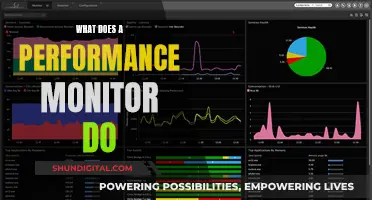
Dryers are a staple in homes across the world, but they can use a lot of electricity. If you're looking to monitor your electricity usage and reduce your energy bills, it's important to know how much power your dryer is using.
In this guide, we will explore the different ways you can measure and calculate your dryer's electricity consumption, from using energy monitors to understanding the technical specifications of your appliance. We will also discuss ways to reduce your energy usage when drying clothes, including hang-drying and using more efficient appliances.
| Characteristics | Values |
|---|---|
| Average Wattage | 1,500 to 5,000 watts |
| Average Monthly Cost | $5.53 |
| Average Yearly Cost | $66.41 |
| Average Voltage | 120-240 volts |
| Average Amperage | 7.5-30 amps |
| Average Usage Per Week | 9 kWh |
| Average Usage Per Month | 39 kWh |
| Average Usage Per Year | 468 kWh |
What You'll Learn

Using a plug load monitor
A plug load monitor is a simple device that can be plugged into an outlet, and then the appliance can be plugged into the monitor. Typically, an LED screen will display the consumption. Plug load monitors are a great way to measure the electricity usage of a dryer.
One of the simplest, least expensive, and best-known plug load monitors is the P3 Kill A Watt EZ, available at Amazon and elsewhere. After a device pulls some power for a while, the monitor can auto-calculate how many kWh the device uses in a day, week, month, or year, providing an instant estimate. It also measures the quality of your line.
The Kill a Watt EZ won't work on all appliances, especially those that use 220V and 230V, as well as those that use more than 120V, such as dryers, most electric water heaters, some electric ranges, and some well pumps.
Many power monitors also allow for electricity use to be converted into cost. While a default value may be pre-entered on a power monitor, monitor users should enter the rate they are charged by their local utility provider to get the most accurate cost estimates from the monitor.
With some monitors, the accumulated kWh data will be 'lost' when the monitor is disconnected, so be sure to record the amounts before disconnecting.
Monitoring Water Usage: Efficient Daily Tracking Methods
You may want to see also

Calculating watts and kilowatts
To monitor the electricity usage of a dryer, you will need to calculate the wattage and kilowatts used by the appliance. Dryers typically use around 1,800 to 5,000 watts, with 3,000 watts being the average. You can find the exact wattage of your dryer in its manual or by searching for the model online.
Now, let's delve into calculating watts and kilowatts:
Watts (W) are a measure of power, while kilowatts (kW) are simply 1,000 watts. To calculate the kilowatts used by an appliance, you divide the total watts consumed by 1,000. For instance, if your dryer uses 3,000 watts, it consumes 3 kilowatts.
Kilowatt-hours (kWh) are used to measure energy usage over time. One kilowatt-hour is equivalent to 1,000 watts of power used for one hour. To calculate kilowatt-hours, you multiply the power in kilowatts by the time in hours.
For example, if you have two loads of laundry that take two hours to dry in a dryer that consumes 3,000 watts on average, you can calculate the kilowatt-hours as follows:
- First, calculate the total watts used: 3,000 watts x 2 hours = 6,000 watts
- Then, convert watts to kilowatts: 6,000 watts / 1,000 = 6 kilowatts
- Finally, calculate kilowatt-hours: 6 kilowatts x 2 hours = 12 kilowatt-hours
So, drying two loads of laundry in this example would consume 12 kilowatt-hours of energy.
You can also use online calculators and conversion tools to make these calculations easier. Additionally, smart plugs and electricity usage monitors can help you track the energy consumption of specific appliances, providing instant estimates of their energy usage.
Monitoring Router Bandwidth Usage: A Step-by-Step Guide
You may want to see also

Comparing energy costs
The cost of running a dryer will depend on several factors, including the wattage of the dryer, the length of the load, and the cost per kilowatt-hour. Let's look at some examples to compare energy costs for different dryers and usage patterns.
Example 1:
Let's consider a dryer with a wattage of 3,000 watts, which is the average wattage for dryers. We'll assume a load time of 2 hours and a cost per kilowatt-hour of $0.13, which is close to the US average.
Using the formula: (wattage x load time) / 1000 x cost per kilowatt-hour, we can calculate the cost per load. In this case, it works out to $0.40 per load.
Example 2:
Now, let's compare this to a more energy-efficient dryer with a wattage of 1,000 watts. We'll keep the same load time of 2 hours and cost per kilowatt-hour of $0.13.
Using the same formula, we find that the cost per load for this dryer is $0.13 per load. That's a significant saving compared to the previous example.
Example 3:
Let's also look at the impact of usage patterns. For a single person doing two loads of laundry per week, the annual energy cost for the 3,000-watt dryer would be $41.60 (assuming 52 weeks in a year).
For a family of four doing four loads per week, the annual energy cost for the same dryer would be $166.40.
Example 4:
Now, let's compare the energy costs of a dryer to another appliance, such as a TV. A typical TV uses between 100-300 watts. We'll take the higher end of this range for our comparison. Assuming a daily usage of 4.5 hours, the weekly energy cost for the TV would be $0.40, which is the same as the cost per load for the 3,000-watt dryer in Example 1.
As we can see from these examples, the energy costs of running a dryer can vary depending on the dryer's wattage, load time, and cost per kilowatt-hour. By choosing a more energy-efficient dryer and being mindful of usage patterns, significant savings can be achieved. Additionally, comparing the energy costs of different appliances can provide valuable context for understanding overall energy usage and costs.
Privacy Concerns: Hotels Monitoring Guest Internet Activity?
You may want to see also

Understanding volts and amps
Volts
The volt is the unit of measurement for electrical voltage and is represented by the letter "V" in electrical equations. Voltage refers to the difference in electrical potential or the number of electrons between any two points in a circuit. It is essentially the "pressure" that moves electrons through a conductor (usually a wire), similar to how water pressure pushes water through a hose.
In the United States, electricity is typically delivered to homes at two voltages: 120 volts and 240 volts. Smaller appliances like TVs, light bulbs, and phone chargers only need 120 volts, while larger, energy-intensive appliances like dryers, air conditioners, and electric ranges require 240 volts.
Amps
The ampere, often shortened to "amp," is the unit of measurement for electrical current and is represented by the letter "I" in electrical equations. Current refers to the speed or rate at which electrons flow through a conductor. In the hose analogy, it is equivalent to the flow rate of water.
The larger the amperage, the more electricity can flow through a circuit. Different circuits in your home are designed to handle specific amperages. For example, large appliances like dryers are typically connected to 30-amp circuits, while most home outlets are powered by 15-amp or 20-amp circuits.
Volts and Amps Together
Ohm's Law relates voltage and current through the equation:
V (voltage) = I (current) x R (resistance)
This means that voltage is equal to the current multiplied by the resistance. If you keep resistance constant and increase voltage, current will also increase. Similarly, if resistance increases while voltage stays the same, current will decrease.
This relationship can be understood through the hose analogy. If you increase the pressure (voltage) in the tank, more water (current) will come out of the hose. On the other hand, if you pinch the hose to increase resistance, less water (current) will come out, even if the pressure (voltage) remains the same.
Calculating with Volts and Amps
You can calculate volts, amps, and resistance using some simple formulas:
- Volts = Watts / Amps
- Amps = Watts / Volts
- Resistance (ohms) = Volts / Amps
These formulas are useful for determining the compatibility of your appliances with your power sources and for calculating the overall power consumption of your electrical system.
Verizon's Home Internet Monitoring: What You Need to Know
You may want to see also

Identifying energy vampires
Energy vampires, also known as phantom energy or standby power, refer to the electricity used by appliances and electronics when they are turned off or in standby mode. Vampire energy can account for 5-10% of the total energy used in your home, and it can cost Americans about $165 per household per year.
Some common energy vampires include:
- Televisions
- Computers
- Refrigerators
- Thermostats
- Electric toothbrushes
- Microwaves
- Coffee makers
- Laptops
- Gaming consoles
- Printers
- Water heaters
- Security systems
To identify energy vampires in your home, look for appliances with continuous displays, internal clocks, temperature monitoring capabilities, or the ability to receive signals from a remote control or Bluetooth device. These features allow the appliances to draw power even when they are turned off.
Additionally, some appliances with light-activated sensors, such as automatic night lights, can also contribute to vampire energy.
Strategies to Reduce Vampire Energy:
- Unplug appliances when not in use. This is the most effective way to reduce vampire energy.
- Use smart power strips that can detect when a device is in standby mode and cut off power accordingly.
- Conduct a home energy audit to assess your energy use and make recommendations for more energy-efficient appliances and lighting options.
- Choose appliances without always-on displays or LED lights. Blinking or glowing lights often indicate an energy vampire.
- Ensure your devices are in good working order. Poorly functioning devices may have issues with the battery or converter, causing them to draw more power.
- Look for the ENERGY STAR certification when purchasing new appliances. These appliances are designed to be more energy-efficient, reducing both active and vampire energy consumption.
Monitoring Bandwidth Usage: PRTG's Per-IP Address Insights
You may want to see also
Frequently asked questions
Dryers use around 1,800 – 5,000 watts, with 3,000 being the average.
First, find the wattage of your dryer in the manual or by searching for the model online. Then, calculate how many kilowatt-hours (kWh) of electricity your dryer uses by multiplying the wattage by the number of hours used per day and dividing that number by 1,000. Finally, multiply the kWh by your cost per kWh, which you can find on your electricity bill.
You can use an electricity usage monitor that plugs into an outlet, such as the P3 Kill A Watt EZ. However, this may not work for dryers that use 220V or 230V.
You can try to avoid over-drying your clothes and hang them up to dry completely instead. Alternatively, you can invest in a more energy-efficient dryer with an Energy Star rating.
Other appliances that use a lot of electricity include air conditioners, washing machines, and heated airers or dryers.







